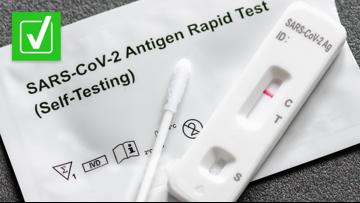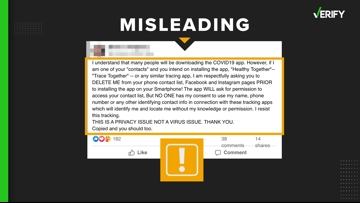As we learn more about the virus that causes COVID-19, public health agencies, including the Centers for Disease Control and Prevention (CDC), have continually updated their guidance to align with scientific developments.
Posts on social media have highlighted an alleged change to the CDC’s definition of vaccine, with some claiming this update took place because the COVID-19 vaccines are ineffective. Several viewers, including Mike, also emailed VERIFY with questions about the CDC changing its vaccine definition.
THE QUESTION
Did the Centers for Disease Control and Prevention (CDC) change its definition of vaccine?
THE SOURCES
- Centers for Disease Control and Prevention (CDC)
- Wayback Machine, a digital archive tool
- Merriam-Webster
THE ANSWER
Yes, the CDC changed its definition of vaccine from “a product that stimulates a person’s immune system to produce immunity to a specific disease, protecting the person from that disease” to “a preparation that is used to stimulate the body’s immune response against diseases.” The public health agency also changed its definition of “vaccination.”
WHAT WE FOUND
An archived CDC web page from May 2018 shows that the agency’s previous definition of vaccine was “a product that stimulates a person’s immune system to produce immunity to a specific disease, protecting the person from that disease.”
The current definition on a CDC web page last updated in September 2021 reads: “A preparation that is used to stimulate the body’s immune response against diseases.”
The latest CDC definition is absent the word “immunity” and just focuses on the stimulation of the body’s immune response.
The CDC also changed its wording for the definition of “vaccination” from “the act of introducing a vaccine into the body to produce immunity to a specific disease” in 2018 to “the act of introducing a vaccine into the body to produce protection from a specific disease.” The key differences here are, again, the absence of the word “immunity” in the latest definition and the change to “protection” instead.
A spokesperson for the CDC told VERIFY in an emailed statement that “while there have been slight changes in wording over time to the definition of ‘vaccine’ on the CDC’s website, those haven’t impacted the overall definition.”
“The previous definition…could be interpreted to mean that vaccines were 100% effective, which has never been the case for any vaccine, so the current definition is more transparent,” the spokesperson wrote in part.
The World Health Organization (WHO) also says on its website that COVID-19 vaccines, in particular, do not provide full (100%) protection, so “breakthrough infections” – where people get the virus even though they are fully vaccinated – will happen.
“It’s also important to note that the modifications to the definition of ‘vaccine’ don’t change the fact that vaccines and the act of vaccination has prevented millions of illnesses and saved countless lives,” the CDC spokesperson added.
Merriam-Webster, which publishes dictionaries in the United States, said “the use of a vaccine that triggers an immune response in an entirely new way” during the COVID-19 pandemic required the company to revise and expand its definition of the word in May 2021. The company’s change was similar to the CDC’s update.
On its website, Merriam-Webster wrote that the definition of vaccine formerly read “a preparation of killed microorganisms, living attenuated organisms, or living fully virulent organisms that is administered to produce or artificially increase immunity to a particular disease.” It was replaced with the following:
1: a preparation that is administered (as by injection) to stimulate the body's immune response against a specific infectious agent or disease: such as
a: an antigenic preparation of a typically inactivated or attenuated (see ATTENUATED sense 2) pathogenic agent (such as a bacterium or virus) or one of its components or products (such as a protein or toxin)
b: a preparation of genetic material (such as a strand of synthesized messenger RNA) that is used by the cells of the body to produce an antigenic substance (such as a fragment of virus spike protein)
The Pfizer and Moderna COVID-19 vaccines, which have both received approval from the U.S. Food and Drug Administration (FDA), are the first messenger RNA (mRNA) shots released to the general public. Many vaccines put a weakened or inactivated germ into the body to trigger an immune response, but that’s not the case with mRNA vaccines, according to the CDC.
These vaccines instead use mRNA created in a laboratory to teach cells how to make a protein, or even a piece of a protein, to trigger an immune response. The immune response then produces antibodies, which protect against infection if the virus enters the body.
While mRNA vaccines are new to the public, researchers have been studying them for decades for viruses such as flu, Zika and rabies, the CDC says. Future mRNA vaccine technology may allow for one vaccine to provide protection against multiple diseases, according to the public health agency.
Medical professionals and public health agencies, including the CDC, say vaccines have been effective against severe disease, hospitalizations and death from COVID-19 during the pandemic. The WHO says “it is very rare for someone vaccinated to experience severe illness or die.”
More from VERIFY: Yes, Spikevax and the Moderna COVID-19 vaccine are the same












